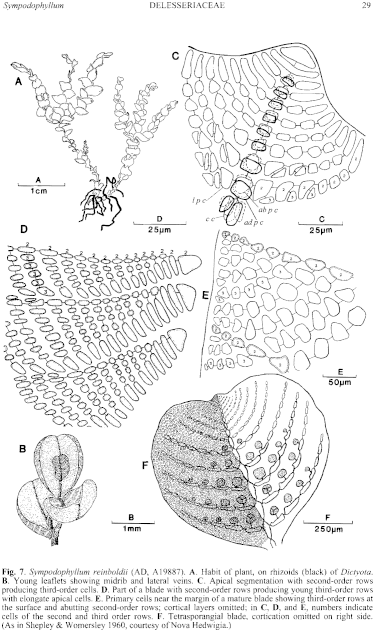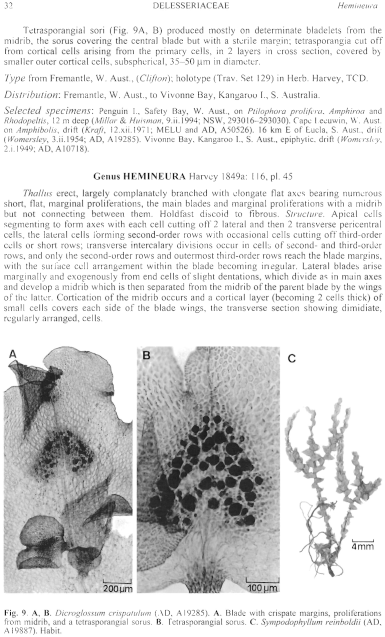|
|
|
|
|
|||||||||||
|
Electronic Flora of South Australia Species Fact Sheet
Phylum Rhodophyta – Family Delesseriaceae
Selected citations: May 1965: 399. Wynne 1996: 181.
Thallus (Figs 7A, 9C) to 4 cm high, with an erect axis 0.5–1.5 mm in diameter bearing small, incurved, axis-clasping ovate blades 1.5–3 mm long, arranged alternately in 2 ranks. Attachment by a small holdfast; epiphytic on rhizoids of Dictyota radicans . Structure. Apex of axes not observed. Blades apparently arising sympodially and endogenously from the midrib of young blades on their adaxial side. Blades concave (Fig. 7B), edges partly inrolled. Apical cells (Fig. 7C) dome-shaped, segmenting to give an axial filament with 2 lateral pericentral cells and soon after 2 transverse pericentral cells, the lateral pericentral cells forming second-order rows (Fig. 7C) with each cell cutting off abaxially a third-order row but only the outer 2 or 3 third-order rows (as well as the second-order rows) reaching the blade margin (Fig. 7D, E); when young, the end cells of third-order rows are elongate but when mature and not dividing they become isodiametric (Fig. 7E); inner blade cells are isodiametric to slightly elongate and 20–30 µm across. In mature blades the cells of second-order rows enlarge and form microscopic lateral veins (Fig. 7B). Cortication of the blades commences early and up to 3 layers of cortex develop on each side. Cortication of the axis also commences early with slender rhizoids, appearing in section as small cells of uniform size surrounding a central core of larger cells. Rhodoplasts discoid.
Reproduction: Gametophytes unknown.
Tetrasporangial sori (Fig. 7F) on blades, with tetrasporangia cut off from cells of second-order rows, forming only a single layer in the thallus, covered by a cortex 1–3 cells thick; tetrasporangia subspherical, 40–60 µm in diameter.
Type from Pondalowie Bay, S. Aust., on Dictyota radicans, drift (Womersley & Wollaston, 24.iv.1955; AD, A19887).
Taxonomic notes: This distinctive but apparently very rare species has never been found since the 1955 collections. It is highly desirable that the apical development and apparent sympodial nature of the axis should be further investigated.
References:
MAY, V. (1965). A census and key to the species of Rhodophyceae (red algae) recorded from Australia. Contr. N.S. W. Natl Herb. 3, 349–429.
SHEPLEY, E.A. & WOMERSLEY, H.B.S. (1960). Sympodophyllum, a new genus of Delesseriaceae (Rhodophyta) from South Australia. Nova Hedwigia 1, 383–388, Plate 76.
WYNNE, M.J. (1996). A revised key to genera of the red algal family Delesseriaceae. Nova Hedwigia 112, 171–190.
The Marine Benthic Flora of Southern Australia Part IIID complete list of references.
Publication:
Womersley, H.B.S. (24 February, 2003)
The Marine Benthic Flora of Southern Australia
Rhodophyta. Part IIID. Ceramiales – Delesseriaceae, Sarcomeniaceae, Rhodomelaceae
Reproduced with permission from The Marine Benthic Flora of Southern Australia Part IIID 2003, by H.B.S. Womersley. Australian Biological Resources Study, Canberra. Copyright Commonwealth of Australia.
Illustrations in Womersley Part IIIA, 2003: FIGS 7, 9C.

Figure 7 enlarge
Fig. 7. Sympodophyllum reinboldii (AD, A19887). A. Habit of plant, on rhizoids (black) of Dictyota. B. Young leaflets showing midrib and lateral veins. C. Apical segmentation with second-order rows producing third-order cells. D. Part of a blade with second-order rows producing young third-order rows with elongate apical cells. E. Primary cells near the margin of a mature blade showing third-order rows at the surface and abutting second-order rows; cortical layers omitted; in C, D, and E, numbers indicate cells of the second and third order rows. F. Tetrasporangial blade, cortication omitted on right side. (As in Shepley & Womersley 1960, courtesy of Nova Hedwigia.)

Figure 9 enlarge
Fig. 9. A, B. Dicroglossum crispatulum (AD, A19285). A. Blade with crispate margins, proliferations from midrib, and a tetrasporangial sorus. B. Tetrasporangial sorus. C. Sympodophyllum reinboldii (AD, A19887). Habit.

|
Email Contact: State Herbarium of South Australia |

|